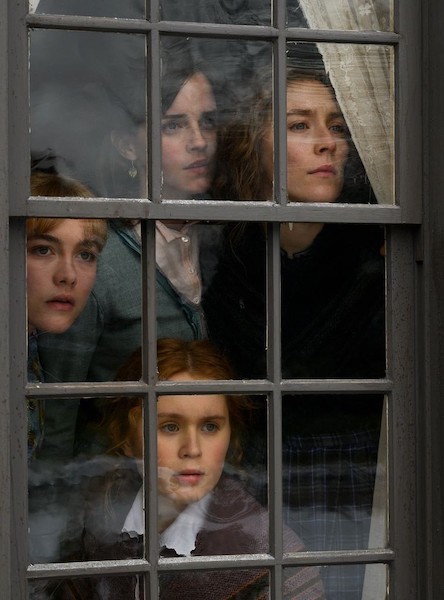The Evolution of Little Women Throughout the Decades
Review of Little Women at SIFF
Written by Teen Writer Disha Cattamanchi and edited by Press Corps Teaching Artist Kathy Fennessy

After many years, we finally have another remake adaptation, but is this remake really worth the hype? Louisa May Alcott’s Little Women, a classic tale about the sisterly bond and womanhood in the 1800s, covers aspects of navigating romantic relationships and careers throughout this harrowing time period. Throughout the years, there have been many adaptations of the story of the March sisters, and Greta Gerwig now adds to that stockpile following Gillian Armstrong’s widely received 1994 version. Gerwig’s Little Women is anything but little, giving it its own unique but strange voice in the myriad of these adaptations. It crumbles boundaries set up in the previous one, but also introduces a rather deeper and equal connection with the sisters, although it relies on an audience with previous exposure to Little Women.
One of the many differences in Gerwig’s rendition, is how the plot is expressed; in this case, through a non-linear timeline. Both the book and many previous adaptations have relied on a linear timeline to grow our relationships with the characters, as they themselves grow up. Though it surprised me, the non-linear timeline does not take away from this; in fact, it adds to it. When we see all of the characters grown up, the flashbacks of childhood make it seem like we are traveling back with them. As we know bits and pieces of the present, our minds have to work to connect the dots, making it feel like we are the ones involved in the relationships, as well. When this happens, however, it can also disrupt the emotion of certain scenes. During some scenes that are meant to be sorrowful, for example, a memory might pop up, adding to a more cheerful mood, disrupting the already established tone. This is fine, but the effect may be jarring, and sometimes takes away the emotional climate of certain scenes.

In the 1994 version, the linear timeline makes the plot progression conventional, though it does preserve the emotion quite well. Scenes can leave you with intense feelings, but the dryness of the landscape and progressing timeline rely more on sorrowful dramatic events to place a certain emotion inside of you. Incidents that are supposed to leave an impending mark are greatly fleshed out as more time is taken to give detail to certain scenes. The result of this is a more emotionally impactful screenplay, that hooks and plays with your feelings in a well-rounded way. Though this may be, it also shows the mediocrity of using scenes intended to be more despairing, than spending more time embedding the emotion in meaningful scenes that add to individual character development such as Gerwig’s does. This means that Armstrong’s plot is more fleshed out than her characters, when Gerwig’s characters are more fleshed out than the plot. As this is an older version, the techniques that were employed to create the film are outdated, though some say that it adds to the magic that older films create.
Gerwig’s screenplay reaches the same effect, just differently. Though her rendition of some dramatic events are impactful, they do not carry across the same deep emotion that Armstrong’s version may trigger. Yet Gerwig employs the use of meaningful monologues and actions to carry out this feeling which makes for a more relatable setting. (Spoiler Alert) When Jo talks to Marmee about wanting to be her own woman but longing for love, Gerwig gives Jo a strong scene that deepens our relationship with the character and gives us the same effect of deep emotion. This is preferable as it relies on the action of relatability,and top-notch acting skills (courtesy of Saoirse Ronan). This allows more meaningful, character-developing moments to shine, rather than tragic events being the showrunner of emotion.
As the March sisters navigate trials and tribulations, such as budding romances and careers, Gerwig employs specific lighting to convey certain moods. This gives the adaptation a three-dimensional feeling unlike the 1994 version which is flat. The tone in the ‘94 version is reused for many scenes, making each one rather the same. The excitement of each scene in Gerwig’s version is not replenished, but using characteristics such as lighting, slow shots, and zooming techniques as an outline for the cinematography, allows for a more variation through each scene. Pinkish and yellowish filters are also used to expand the views of different moods while differentiating time jumps.
Gerwig’s Little Women stands far apart from other adaptations through its use of different cinematography techniques and an unusual screenplay, shouting out unique. Her adaptation is not just another Little Women retelling, but another view of a loving sisterly bond. At the end of the day, she successfully illustrated women’s struggle between desire and duty through the lens of the 1800s, though it still may be applicable for modern times. And with the likes of a very talented cast, including Emma Watson (“Meg”), Timothée Chalamet (“Laurie”), and Meryl Streep (“Aunt March”), this adaptation is very strange, and for the best.
Lead photo caption: Emma Watson, Saoirse Ronan, Florence Pugh, and Eliza Scanlen in Little Women (2019).
This article was written as part of the Film Criticism Workshop presented in collaboration with SIFF, on January 17-25, 2020. This workshop was taught by Press Corps Teaching Artist and film critic, Kathy Fennessy.
The TeenTix Press Corps promotes critical thinking, communication, and information literacy through criticism and journalism practice for teens. For more information about other Press Corps programs including the Teen Editorial Staff or the TeenTix Newsroom, see HERE.

